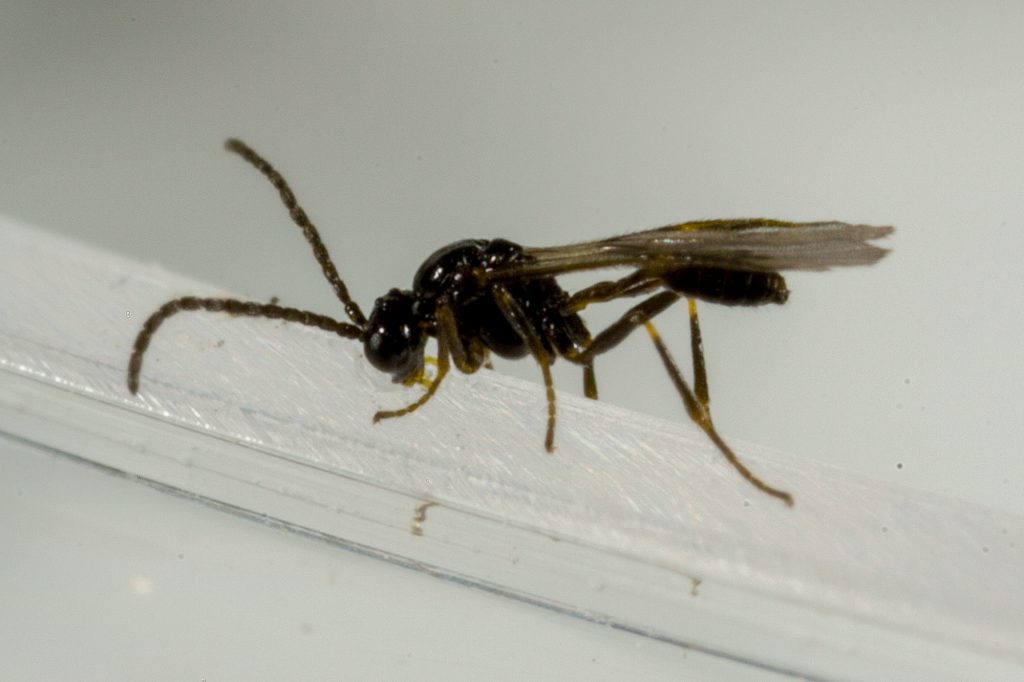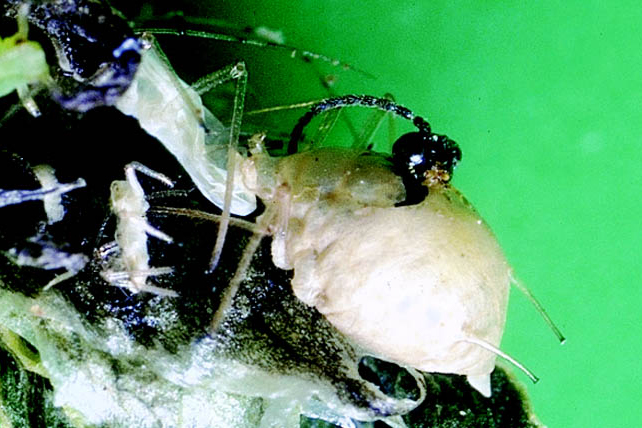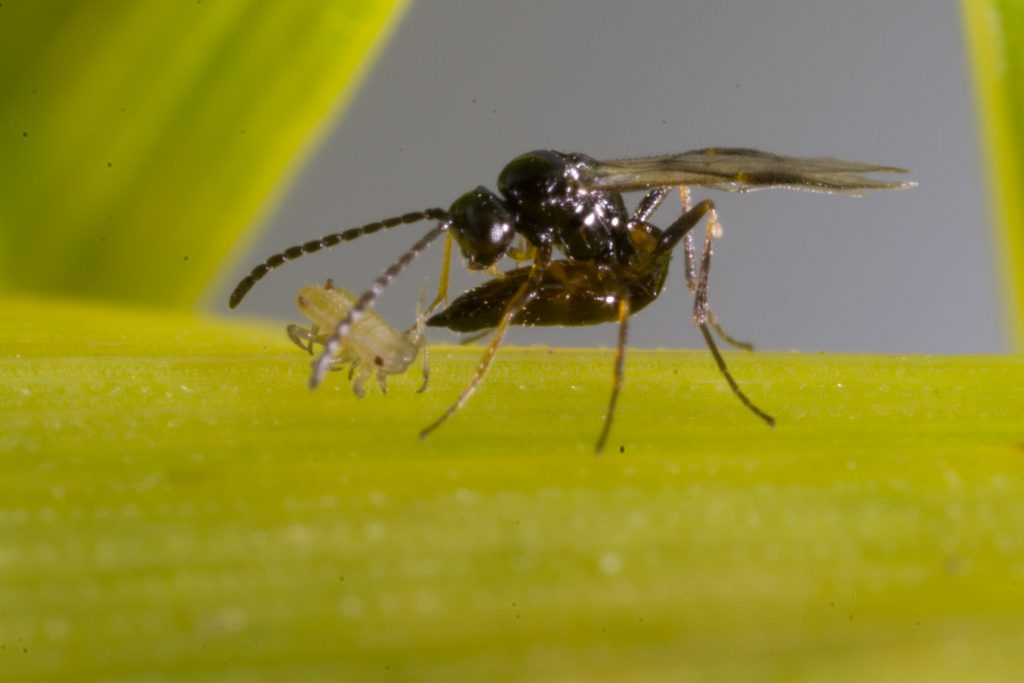Aphid parasitoids

Photo by Andrew Weeks, Cesar Australia
Summary Top
Aphid parasitoids are minute wasps that lay their eggs into the bodies of live aphids, eventually killing them. The immature parasitoids develop within the aphid body before emerging as adults. In crops, the activity of aphid parasitoids is seen as aphid ‘mummies’, which look like swollen, bronze-brown coloured aphids. In winter-grown crops, suppression of aphid populations by parasitoids is most common from late winter through spring, although their effect can be limited if broad-spectrum sprays are applied, or if the aphid populations enter a rapid growth phase.
Occurrence Top
Aphid parasitoids can usually be found wherever there are aphid populations, however, there is always a delay between the establishment of aphids in a crop and the arrival of aphid parasitoids. Because of their small size, the presence of aphid parasitoids may first be detected by the presence of aphid ‘mummies’, which appear as static, swollen, bronze-brown coloured aphids stuck to the plant. Sightings of aphid ‘mummies’ in crops is an indicator that parasitism has been occurring for some time and that many more aphids are also likely to have been parasitised but not reached the mummy stage.
Sightings of aphid ‘mummies’ are an indicator that parasitism has been occurring for some time.
Description Top
Aphid parasitoids are minute wasps belonging to the order Hymenoptera. There are many parasitoids that attack aphids in Australia, the most common of these come from the genera Aphidius, Aphelinus, Diaeretiella, Lysiphlebus and Trioxys (subfamily Aphidiinae). Each parasitoid species may attack either one or a number of species of aphid and as there is often overlap in their preference, there may be several parasitoids that attack each species of aphid. For example, Lysiphlebus testaceipes attacks corn aphid, oat aphid and cowpea aphid, Aphidius colemani attacks green peach aphid, turnip aphid, corn aphid and oat aphid, Aphidius ervi attacks rose grain aphid, blue green aphid and pea aphid, while Diaeretiella rapae attacks cabbage aphid.
All aphid parasitoids are small (mostly 2-3 mm and less than 5 mm long) and usually dark in colour.

Lifecycle Top
Each female parasitoid can lay hundreds of eggs during her life. Each egg laid into an aphid hatches and the larva feeds on the aphid from within, eventually killing it. Development of the immature stages of a parasitoid is completed entirely within the body of the host aphid. Developmental times vary with species as well as temperature, but it takes approximately one to two weeks before immature parasitoids emerge as adults.
The parasitoid larva then builds a cocoon for pupation. This is the stage that produces the recognisable ‘aphid mummy’ appearance whereby aphids bloat and change to a brown/gold colour. When the new adult emerges from the parasitoid pupa, it cuts an escape hole in the back of the aphid mummy and will immediately go in search of food (nectar and pollen) as well as a mate. Once mated, the females search for aphids in which to lay their eggs, using the scent of the aphids as a guide.

Behaviour Top
Female parasitoids insert their eggs into the bodies of live aphids, where the developing larva feed on aphid body fluids. Aphids can also fight back against attack by parasitoids. Wasps may be injured by large aphids, or entangled in the cornical wax that aphids sometimes secrete in response to parasitoid activity in the colony.

All adult parasitoids require nectar and pollen as a food source, most of which can be found within or adjacent to a crop.
Similar to Top
Other wasp parasitoids that attack caterpillars such as the Brachonids; these are usually slightly larger.
Management options Top
Biological
The establishment of populations of aphid parasitoids on a crop often begins at the start of the season but they are unlikely to impose substantial aphid control during the establishment phase. Aphid parasitoids can be effective at controlling low to medium density populations of aphids within post-establishment crops. However, this assumes that parasitoid populations have been allowed to persist undisturbed by broad-spectrum insecticides during earlier stages of crop development when aphid populations are beginning to build up. Softer chemicals can be used against aphids with minimal impact on beneficials.
Acknowledgements Top
This article was compiled at cesar by Alana Govender (cesar).
References/Further Reading Top
Carver M and Franzmann B. 2001. Lysiphlebus Förster (Hymenoptera: Braconidae: Aphidiinae) in Australia. Australian Journal of Entomology 40, 198-201.
Edwards OR, Franzmann B, Thackray D and Micic S. 2008. Insecticide resistance and implications for future aphid management in Australian grains and pastures: a review. Australian Journal of Experimental Agriculture 48, 1523-1530.
Henry K, Bellati J, Umina P and Wurst M. 2008. Crop Insects: the Ute Guide Southern Grain Belt Edition. Government of South Australia PIRSA and GRDC.
Longley M. 1999. A review of pesticide effects upon aphid parasitoids within mummified hosts. International Journal of Pest Management 45(2), 139-145.
NIPI 2014. IPM Guidelines for Grains. Aphid parasitoids. http://ipmguidelinesforgrains.com.au/pests/aphids/aphid-parasitoids/
| Date | Version | Author(s) | Reviewed by |
|---|---|---|---|
| February 2016 | 1.0 | Alana Govender (cesar) | Garry McDonald (cesar), Bill Kimber (SARDI) |
What are PestNotes?
PestNotes are information sheets developed through a collaboration between Cesar Australia and the South Australian Research and Development Institute (SARDI). Copyright: © All material published in PestNotes is copyright protected by Cesar Australia and SARDI and may not be reproduced in any form without written permission from both agencies.
Disclaimer
The material provided in PestNotes is based on the best available information at the time of publishing. No person should act on the basis of the contents of this publication without first obtaining independent, professional advice. PestNotes may identify products by proprietary or trade names to help readers identify particular products. We do not endorse or recommend the products of any manufacturer referred to. Other products may perform as well as or better than those specifically referred to. Cesar Australia and PIRSA will not be liable for any loss, damage, cost or expense incurred or arising by reason of any person using or relying on the information in this publication. Any research with unregistered pesticides or products referred to in PestNotes does not constitute a recommendation for that particular use.

